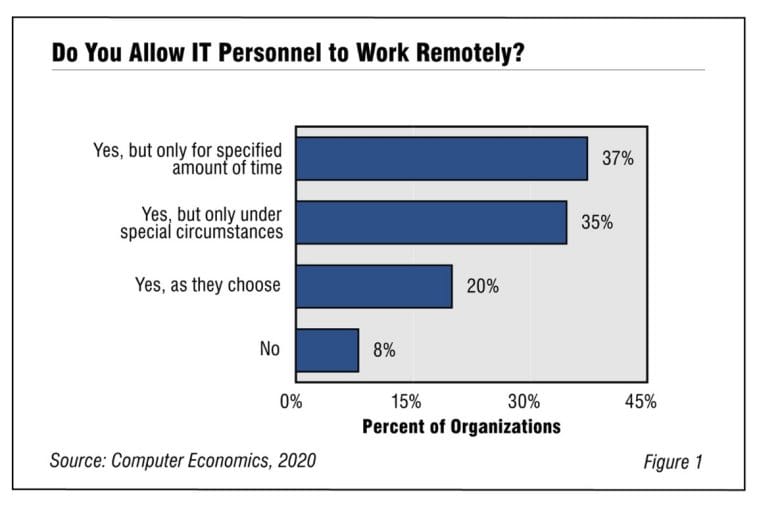The practice of working remotely has skyrocketed over the past 11 years for many reasons, and in early 2020 it got a huge boost with the COVID-19 pandemic. Untold millions of workers around the world started working from home in March 2020, after thousands of companies and governments instructed employees to work remotely for a time, if they are able to.
Despite the pandemic, the trend toward telecommuting was already well under way. To get a handle on how much telecommuting is occurring, we posed a series of questions to IT managers, including asking them to estimate the percentage of their total staff that works from home at one of three levels. The results are in Figure 1 from the full report, Trends in Telecommuting in the IT Workforce.
The figure shows that the top choice, at 37%, is “only a specified amount of time.” Close behind that is “only under special circumstances” at 35%. In third place is the 20% of IT organizations that allow personnel to work from home as they choose. Only 8% of respondents did not allow any telecommuting in 2019.

The last time we conducted research on telecommuting, in 2008, a whopping 64% of IT organizations did not allow their personnel to work from home, at any level. In 2019, a measly 8% of IT organizations did not allow personnel to work from home, regardless of how often it occurred or the reasons for it.
Why is telecommuting up so much, even before the pandemic? It has been enabled by a number of technologies, such as the proliferation of high-speed internet, mobile devices, remote access, low-cost web conferencing, VoIP, and cloud computing. In addition, concerns about work/life balance and workforce retention contribute to the trend. Business continuity in the face of a pandemic is just one more benefit of the trend.
“Many business leaders are learning a hard lesson in 2020,” said Tom Dunlap, research director for Computer Economics, an Avasant company. “What’s the lesson? Having robust, companywide telecommuting capabilities in place—even if only used one or two days a week—should be deployed as a contingency measure during pandemics or other natural disasters.”
The full report is based on a survey and study of IT salary data conducted during the second half of 2019. The study begins with a survey we conduct each year, gathering data from 75 IT organizations on median salaries and bonuses paid to their IT staffs for positions under study. We study how much telecommuting is allowed overall, the percentage of IT staff that work at home at least one day a week, and the top reasons for it. We conclude with best-practice recommendations.
This Research Byte is a brief overview of our report on this subject, Trends in Telecommuting in the IT Workforce. The full report is available at no charge for Avasant Research subscribers, or it may be purchased by non-subscribers directly from our website (click for pricing).

